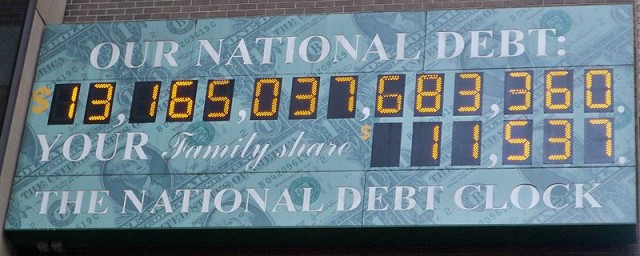What Happens When the Sky Isn’t Falling?
by B. Traven

The past few years have seen an endless parade of front-page headlines about battles over the growing deficit, the debt ceiling, the fiscal cliff, the sequester, and entitlement costs. The government will shut down tomorrow if nothing is done! The United States may default on its debts and become an international laughingstock! Social Security, Medicare, and Medicaid are facing imminent collapse! Etc.
It’s not hard to understand why America’s editors would lavish these dramatic stories with wall-to-wall news coverage. But what happens when a crisis recedes? What if things aren’t as bad as we thought? Well, those stories go on the inside pages of the business section, apparently.
Take the recent revelation that the economic recovery is boosting tax revenues and deficits are shrinking faster than expected, pushing back the day of reckoning for the (still unresolved) debt ceiling debate. Despite both of those stories mostly being mainly about the maneuvering of politicians, and not the underlying economics, they were run in the business section under dull, sober headlines.
One big reason the deficit is falling faster than expected is a surprising — and surprisingly durable — drop in health care spending, the source of most of America’s long-term fiscal problems. The seemingly inexorable rise in health care costs has been near the center of every big political and economic debate since Obama was elected. But the fact that it’s finally slowing down was deemed worthy only of page B3 by editors at The New York Times.
To be fair, the health care spending study and the deficit story were covered on the many economics blogs catering to wonks, and spread between Obama supporters who saw it as evidence his health care and recovery plans are working. Paul Krugman, who attacks deficit-hawkism almost every week in his widely-read column, has also touched on these themes once or twice over on the editorial page.
But the falling deficit simply wasn’t treated as a Big Story by the mainstream news establishment that provides us with saturation coverage of every twist and turn in the (fundamentally meaningless) debt ceiling fight. Why?
Well, it’s easy to get worked up about a LOOMING CRISIS or a SHOWDOWN or FALLING OFF THE CLIFF. Those stories are far more exciting to write — and to read — than the usual kind of macroeconomic stories that newspaper journalists get to write, about some vague number slowly moving up or down (or, even more boringly, staying the same).
And as stupid as these manufactured crises are, it would be inappropriate for journalists to ignore them completely: they are manufactured in such a way that they really could lead to dire consequences. Those reporters just need to put some of the same energy into letting us know when things get better, too!
Photo: Matthew G. Bisanz/Wikimedia Commons
Support The Billfold
The Billfold continues to exist thanks to support from our readers. Help us continue to do our work by making a monthly pledge on Patreon or a one-time-only contribution through PayPal.
Comments